Knowledge Management: Case Study, Codification, and Development
VerifiedAdded on 2022/10/17
|11
|2045
|142
Homework Assignment
AI Summary
This assignment addresses key aspects of knowledge management through a case study approach. It begins by exploring methods companies can use to enhance employee perception and motivation without relying solely on salary increases, including flexible working hours, non-monetary gifts, and sponsored trips. The assignment then delves into knowledge codification using frames to represent concepts such as horses, students, and pilots, along with the benefits of this codification process. Furthermore, it evaluates different approaches to knowledge development, advocating for a rigorous, analytical individual for designing knowledge-based systems. The assignment also analyzes the failure of knowledge management implementation in a global company, examining the issues across five stages of knowledge management: advocate and learn, develop strategy, design and launch KM initiatives, expand and support initiatives, and institutionalize knowledge management, along with recommendations for improvement. The assignment also uses brainstorming, nominal group technique and consensus decision making to find solutions to the employee personal-worth perception problem.
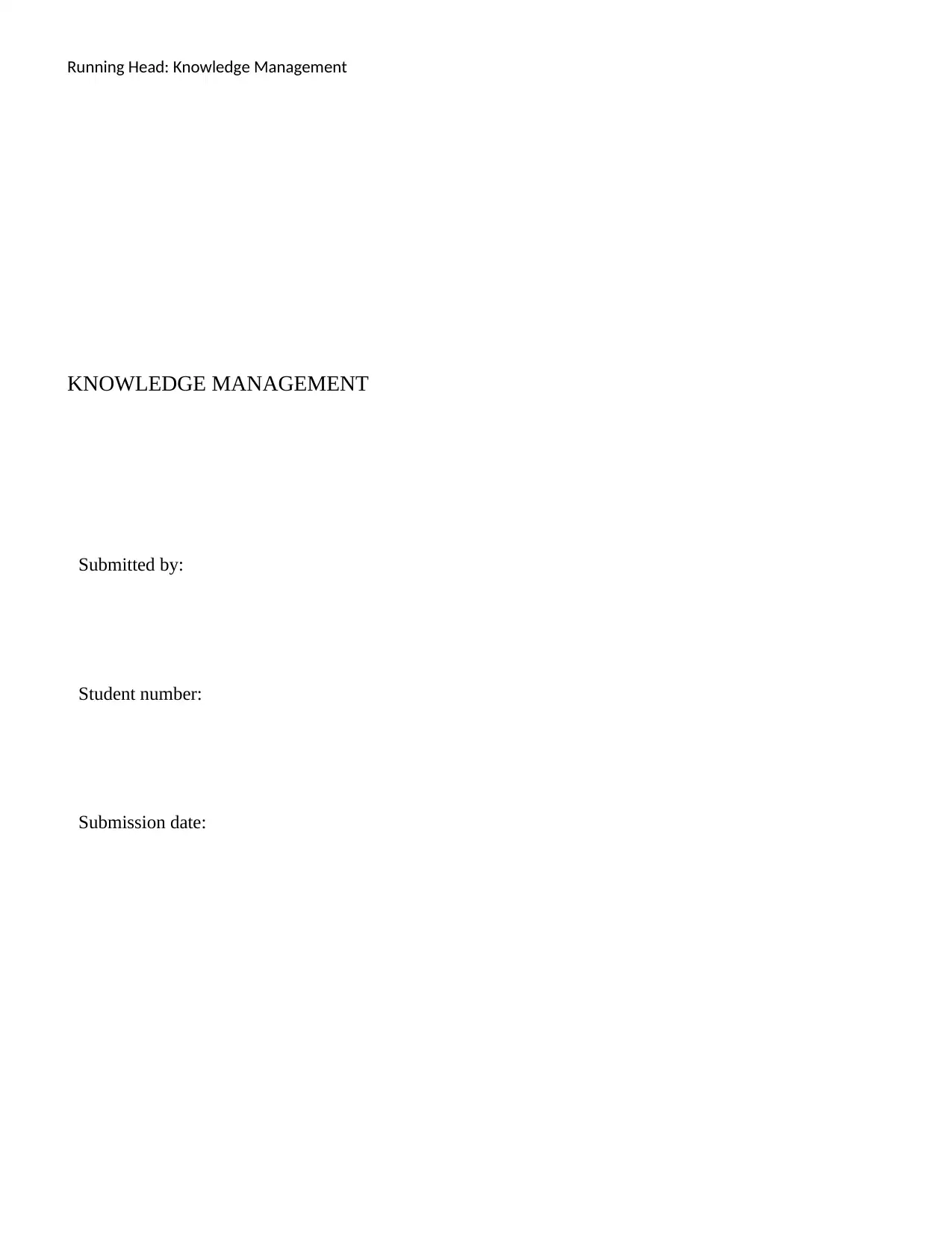
Running Head: Knowledge Management
KNOWLEDGE MANAGEMENT
Submitted by:
Student number:
Submission date:
KNOWLEDGE MANAGEMENT
Submitted by:
Student number:
Submission date:
Paraphrase This Document
Need a fresh take? Get an instant paraphrase of this document with our AI Paraphraser
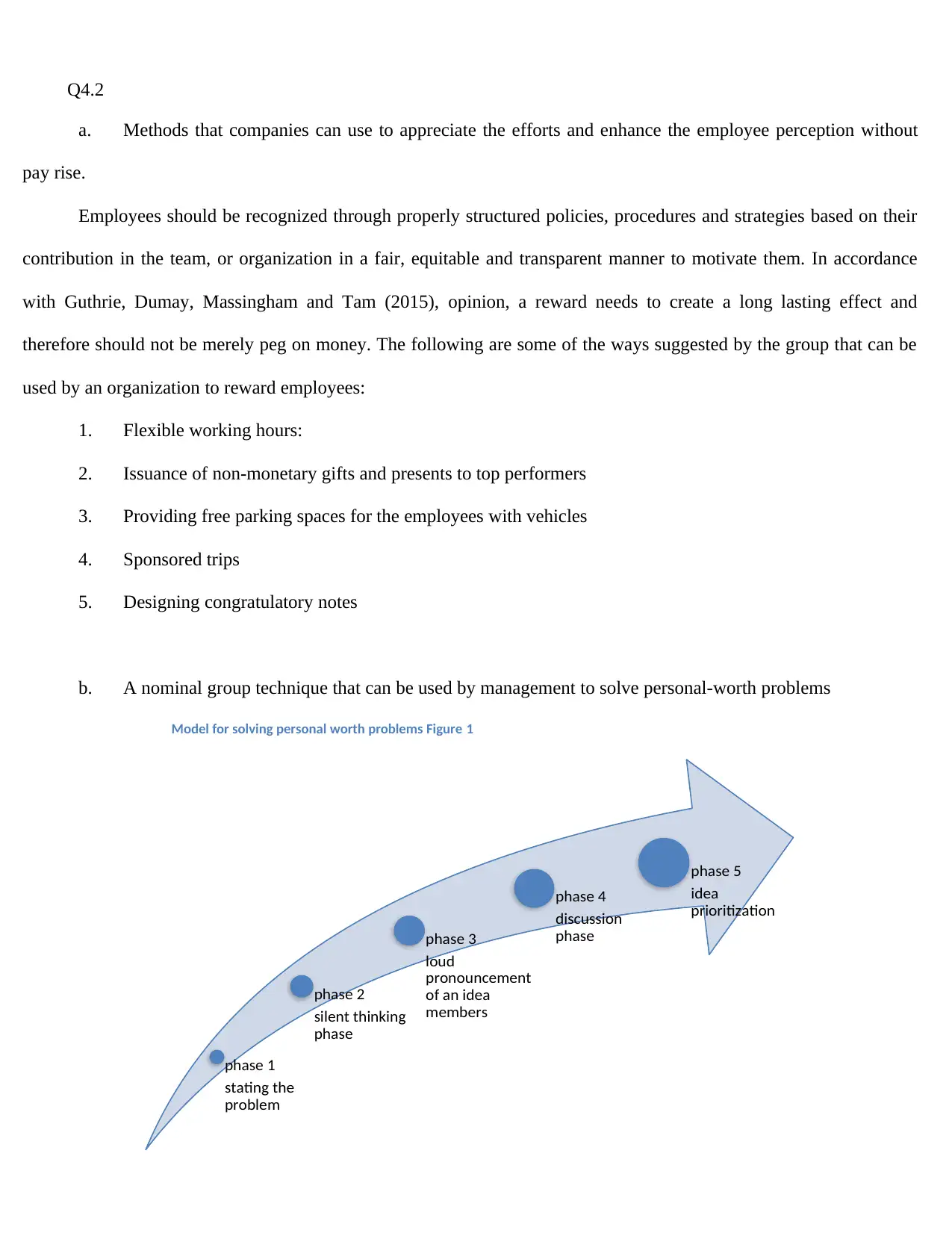
Q4.2
a. Methods that companies can use to appreciate the efforts and enhance the employee perception without
pay rise.
Employees should be recognized through properly structured policies, procedures and strategies based on their
contribution in the team, or organization in a fair, equitable and transparent manner to motivate them. In accordance
with Guthrie, Dumay, Massingham and Tam (2015), opinion, a reward needs to create a long lasting effect and
therefore should not be merely peg on money. The following are some of the ways suggested by the group that can be
used by an organization to reward employees:
1. Flexible working hours:
2. Issuance of non-monetary gifts and presents to top performers
3. Providing free parking spaces for the employees with vehicles
4. Sponsored trips
5. Designing congratulatory notes
b. A nominal group technique that can be used by management to solve personal-worth problems
Model for solving personal worth problems Figure 1
phase 1
stating the
problem
phase 2
silent thinking
phase
phase 3
loud
pronouncement
of an idea
members
phase 4
discussion
phase
phase 5
idea
prioritization
a. Methods that companies can use to appreciate the efforts and enhance the employee perception without
pay rise.
Employees should be recognized through properly structured policies, procedures and strategies based on their
contribution in the team, or organization in a fair, equitable and transparent manner to motivate them. In accordance
with Guthrie, Dumay, Massingham and Tam (2015), opinion, a reward needs to create a long lasting effect and
therefore should not be merely peg on money. The following are some of the ways suggested by the group that can be
used by an organization to reward employees:
1. Flexible working hours:
2. Issuance of non-monetary gifts and presents to top performers
3. Providing free parking spaces for the employees with vehicles
4. Sponsored trips
5. Designing congratulatory notes
b. A nominal group technique that can be used by management to solve personal-worth problems
Model for solving personal worth problems Figure 1
phase 1
stating the
problem
phase 2
silent thinking
phase
phase 3
loud
pronouncement
of an idea
members
phase 4
discussion
phase
phase 5
idea
prioritization
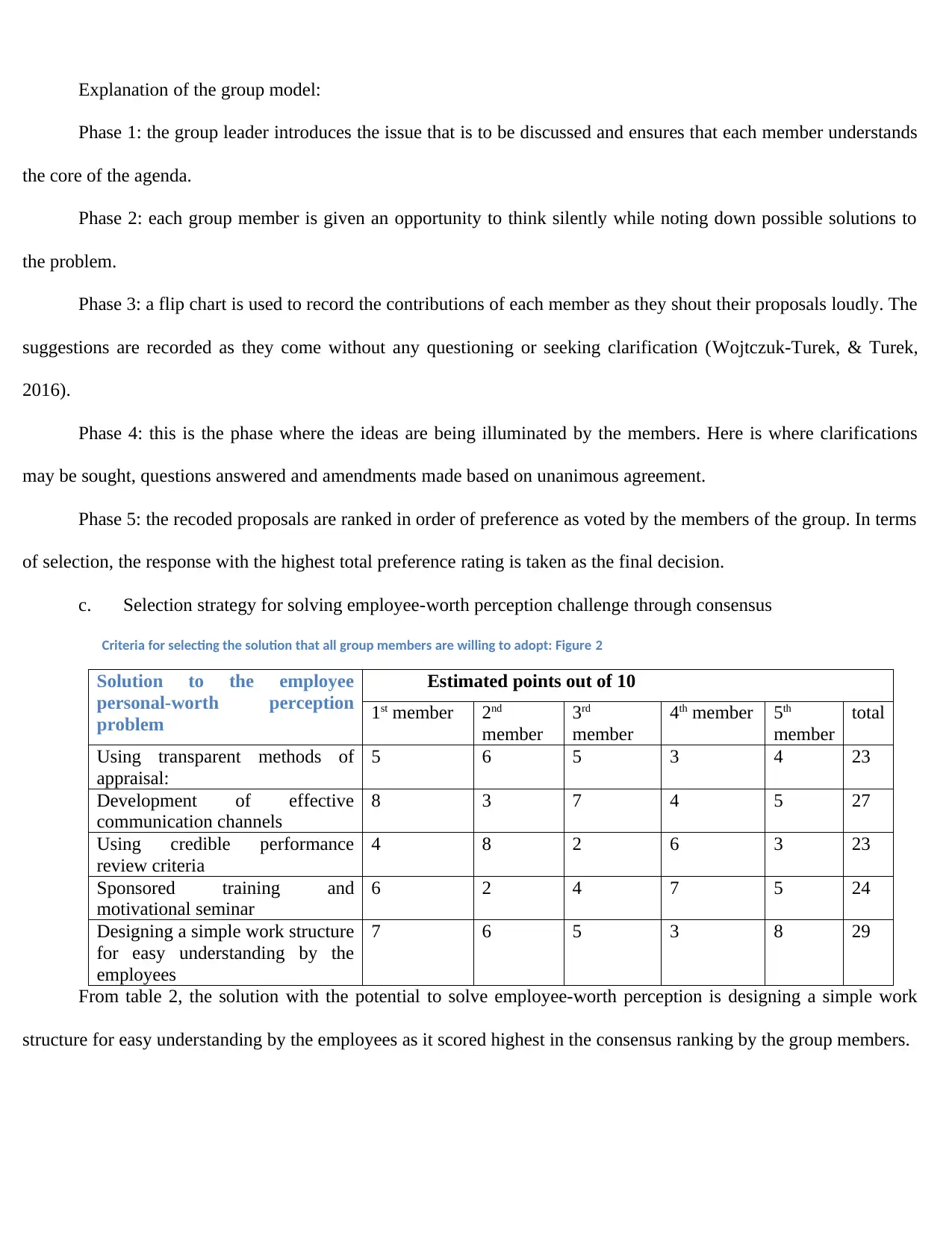
Explanation of the group model:
Phase 1: the group leader introduces the issue that is to be discussed and ensures that each member understands
the core of the agenda.
Phase 2: each group member is given an opportunity to think silently while noting down possible solutions to
the problem.
Phase 3: a flip chart is used to record the contributions of each member as they shout their proposals loudly. The
suggestions are recorded as they come without any questioning or seeking clarification (Wojtczuk-Turek, & Turek,
2016).
Phase 4: this is the phase where the ideas are being illuminated by the members. Here is where clarifications
may be sought, questions answered and amendments made based on unanimous agreement.
Phase 5: the recoded proposals are ranked in order of preference as voted by the members of the group. In terms
of selection, the response with the highest total preference rating is taken as the final decision.
c. Selection strategy for solving employee-worth perception challenge through consensus
Criteria for selecting the solution that all group members are willing to adopt: Figure 2
Solution to the employee
personal-worth perception
problem
Estimated points out of 10
1st member 2nd
member
3rd
member
4th member 5th
member
total
Using transparent methods of
appraisal:
5 6 5 3 4 23
Development of effective
communication channels
8 3 7 4 5 27
Using credible performance
review criteria
4 8 2 6 3 23
Sponsored training and
motivational seminar
6 2 4 7 5 24
Designing a simple work structure
for easy understanding by the
employees
7 6 5 3 8 29
From table 2, the solution with the potential to solve employee-worth perception is designing a simple work
structure for easy understanding by the employees as it scored highest in the consensus ranking by the group members.
Phase 1: the group leader introduces the issue that is to be discussed and ensures that each member understands
the core of the agenda.
Phase 2: each group member is given an opportunity to think silently while noting down possible solutions to
the problem.
Phase 3: a flip chart is used to record the contributions of each member as they shout their proposals loudly. The
suggestions are recorded as they come without any questioning or seeking clarification (Wojtczuk-Turek, & Turek,
2016).
Phase 4: this is the phase where the ideas are being illuminated by the members. Here is where clarifications
may be sought, questions answered and amendments made based on unanimous agreement.
Phase 5: the recoded proposals are ranked in order of preference as voted by the members of the group. In terms
of selection, the response with the highest total preference rating is taken as the final decision.
c. Selection strategy for solving employee-worth perception challenge through consensus
Criteria for selecting the solution that all group members are willing to adopt: Figure 2
Solution to the employee
personal-worth perception
problem
Estimated points out of 10
1st member 2nd
member
3rd
member
4th member 5th
member
total
Using transparent methods of
appraisal:
5 6 5 3 4 23
Development of effective
communication channels
8 3 7 4 5 27
Using credible performance
review criteria
4 8 2 6 3 23
Sponsored training and
motivational seminar
6 2 4 7 5 24
Designing a simple work structure
for easy understanding by the
employees
7 6 5 3 8 29
From table 2, the solution with the potential to solve employee-worth perception is designing a simple work
structure for easy understanding by the employees as it scored highest in the consensus ranking by the group members.
⊘ This is a preview!⊘
Do you want full access?
Subscribe today to unlock all pages.

Trusted by 1+ million students worldwide
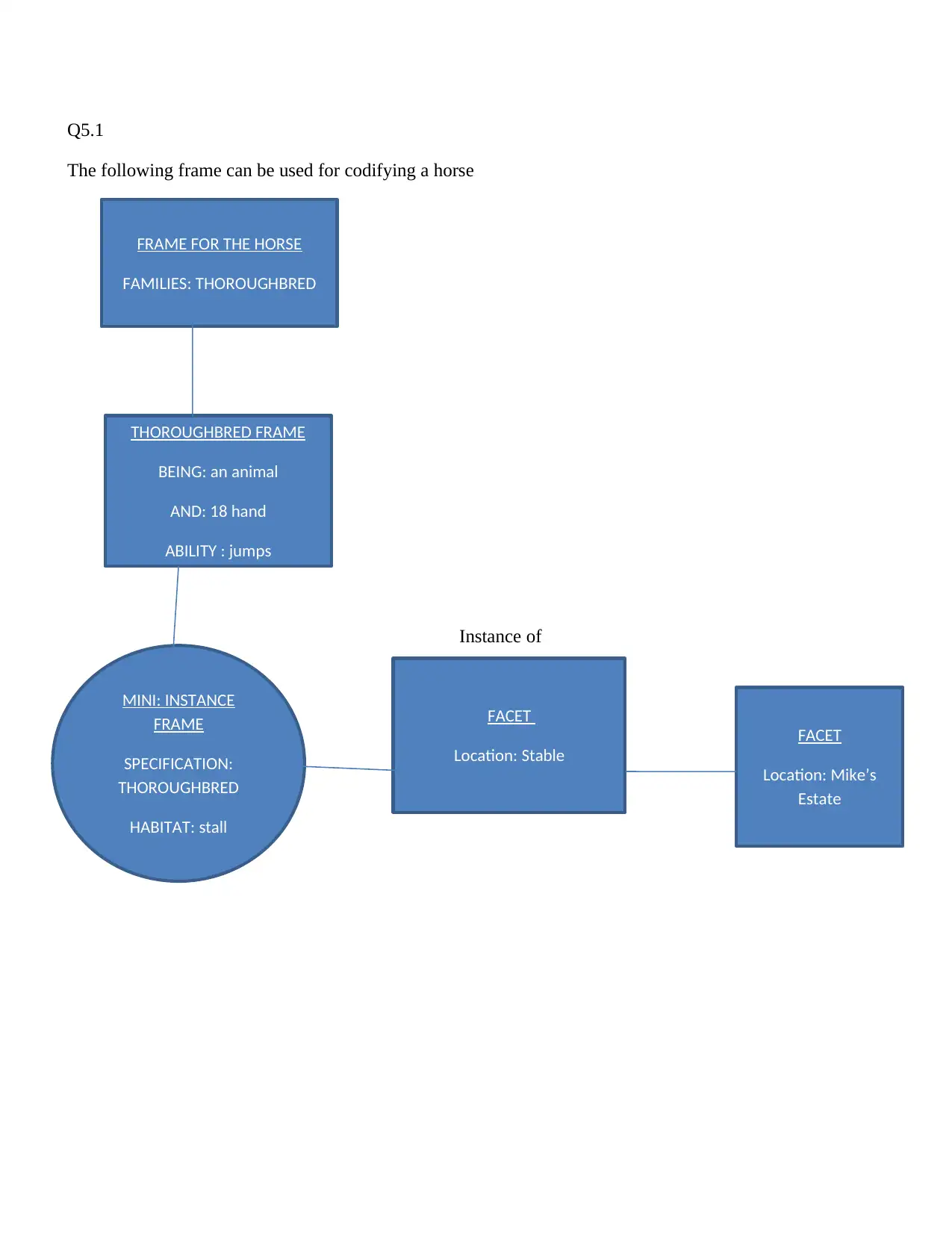
Q5.1
The following frame can be used for codifying a horse
Instance of
FRAME FOR THE HORSE
FAMILIES: THOROUGHBRED
THOROUGHBRED FRAME
BEING: an animal
AND: 18 hand
ABILITY : jumps
MINI: INSTANCE
FRAME
SPECIFICATION:
THOROUGHBRED
HABITAT: stall
FACET
Location: Stable
FACET
Location: Mike’s
Estate
The following frame can be used for codifying a horse
Instance of
FRAME FOR THE HORSE
FAMILIES: THOROUGHBRED
THOROUGHBRED FRAME
BEING: an animal
AND: 18 hand
ABILITY : jumps
MINI: INSTANCE
FRAME
SPECIFICATION:
THOROUGHBRED
HABITAT: stall
FACET
Location: Stable
FACET
Location: Mike’s
Estate
Paraphrase This Document
Need a fresh take? Get an instant paraphrase of this document with our AI Paraphraser
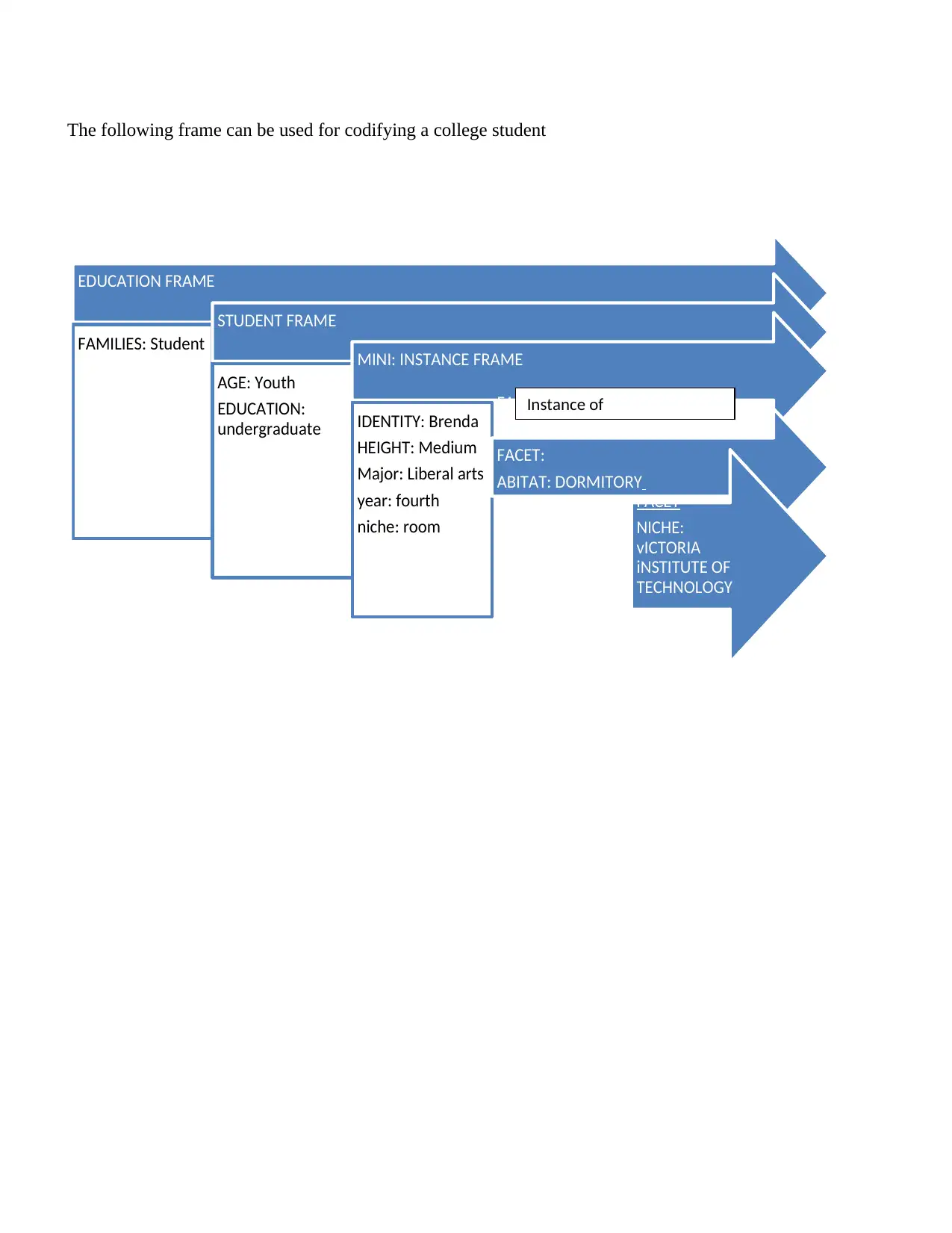
The following frame can be used for codifying a college student
EDUCATION FRAME
FAMILIES: Student
STUDENT FRAME
AGE: Youth
EDUCATION:
undergraduate
MINI: INSTANCE FRAME
IDENTITY: Brenda
HEIGHT: Medium
Major: Liberal arts
year: fourth
niche: room
FACET:
FACET:
ABITAT: DORMITORY
TEEWWTT FACET
NICHE:
vICTORIA
iNSTITUTE OF
TECHNOLOGY
Instance of
EDUCATION FRAME
FAMILIES: Student
STUDENT FRAME
AGE: Youth
EDUCATION:
undergraduate
MINI: INSTANCE FRAME
IDENTITY: Brenda
HEIGHT: Medium
Major: Liberal arts
year: fourth
niche: room
FACET:
FACET:
ABITAT: DORMITORY
TEEWWTT FACET
NICHE:
vICTORIA
iNSTITUTE OF
TECHNOLOGY
Instance of
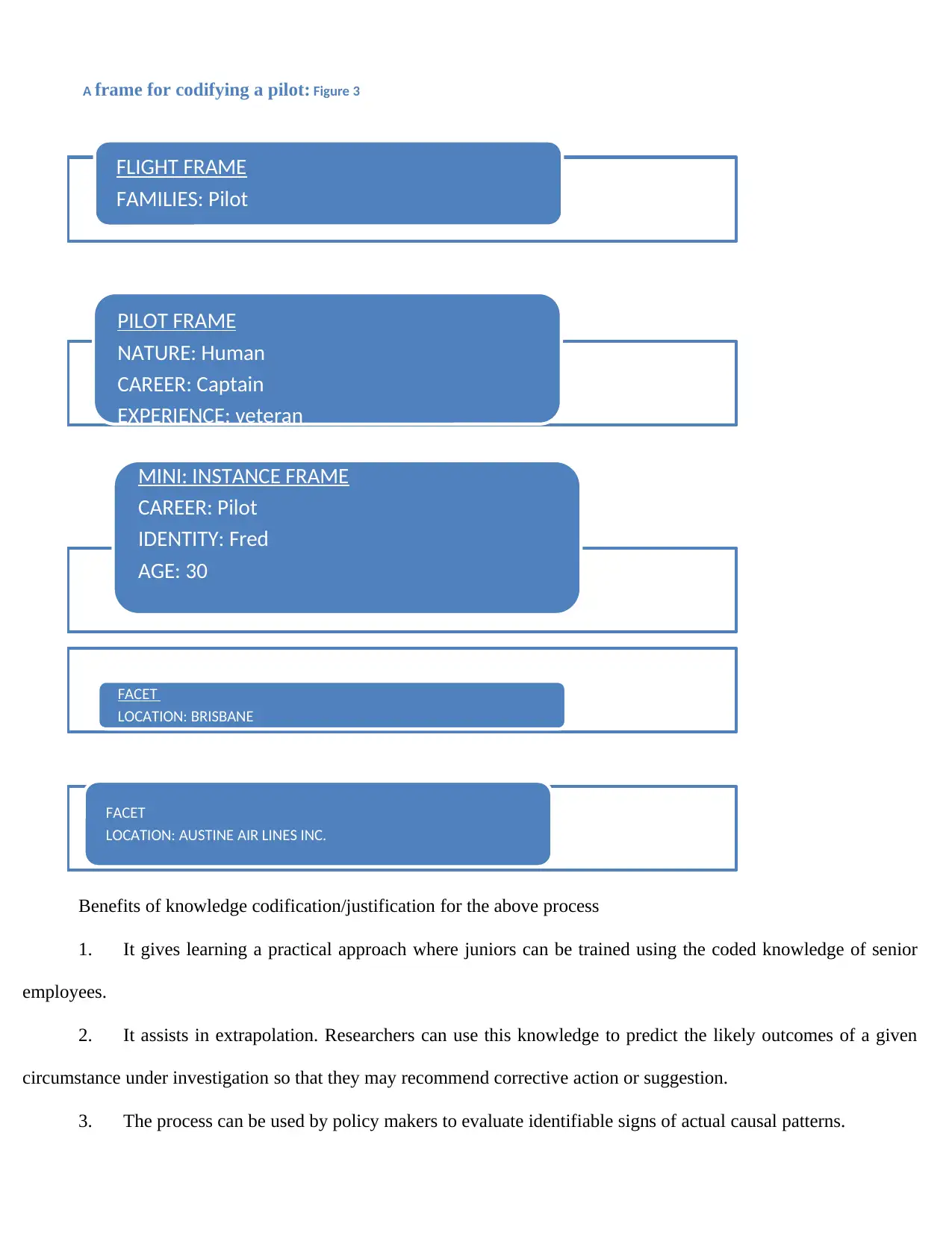
A frame for codifying a pilot: Figure 3
Benefits of knowledge codification/justification for the above process
1. It gives learning a practical approach where juniors can be trained using the coded knowledge of senior
employees.
2. It assists in extrapolation. Researchers can use this knowledge to predict the likely outcomes of a given
circumstance under investigation so that they may recommend corrective action or suggestion.
3. The process can be used by policy makers to evaluate identifiable signs of actual causal patterns.
FLIGHT FRAME
FAMILIES: Pilot
PILOT FRAME
NATURE: Human
CAREER: Captain
EXPERIENCE: veteran
CCA
MINI: INSTANCE FRAME
CAREER: Pilot
IDENTITY: Fred
AGE: 30
FACET
LOCATION: BRISBANE
FACET
LOCATION: AUSTINE AIR LINES INC.
Benefits of knowledge codification/justification for the above process
1. It gives learning a practical approach where juniors can be trained using the coded knowledge of senior
employees.
2. It assists in extrapolation. Researchers can use this knowledge to predict the likely outcomes of a given
circumstance under investigation so that they may recommend corrective action or suggestion.
3. The process can be used by policy makers to evaluate identifiable signs of actual causal patterns.
FLIGHT FRAME
FAMILIES: Pilot
PILOT FRAME
NATURE: Human
CAREER: Captain
EXPERIENCE: veteran
CCA
MINI: INSTANCE FRAME
CAREER: Pilot
IDENTITY: Fred
AGE: 30
FACET
LOCATION: BRISBANE
FACET
LOCATION: AUSTINE AIR LINES INC.
⊘ This is a preview!⊘
Do you want full access?
Subscribe today to unlock all pages.

Trusted by 1+ million students worldwide
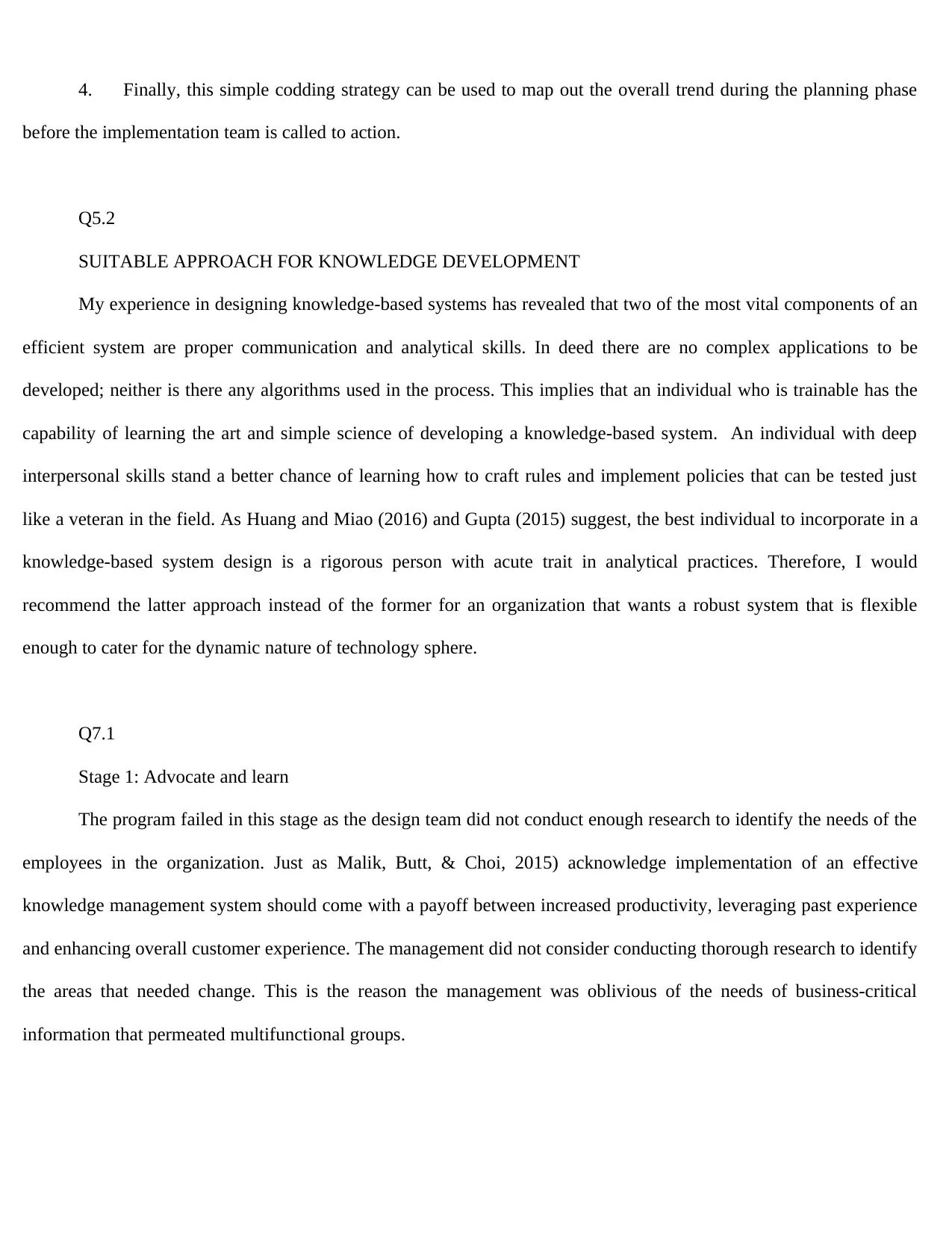
4. Finally, this simple codding strategy can be used to map out the overall trend during the planning phase
before the implementation team is called to action.
Q5.2
SUITABLE APPROACH FOR KNOWLEDGE DEVELOPMENT
My experience in designing knowledge-based systems has revealed that two of the most vital components of an
efficient system are proper communication and analytical skills. In deed there are no complex applications to be
developed; neither is there any algorithms used in the process. This implies that an individual who is trainable has the
capability of learning the art and simple science of developing a knowledge-based system. An individual with deep
interpersonal skills stand a better chance of learning how to craft rules and implement policies that can be tested just
like a veteran in the field. As Huang and Miao (2016) and Gupta (2015) suggest, the best individual to incorporate in a
knowledge-based system design is a rigorous person with acute trait in analytical practices. Therefore, I would
recommend the latter approach instead of the former for an organization that wants a robust system that is flexible
enough to cater for the dynamic nature of technology sphere.
Q7.1
Stage 1: Advocate and learn
The program failed in this stage as the design team did not conduct enough research to identify the needs of the
employees in the organization. Just as Malik, Butt, & Choi, 2015) acknowledge implementation of an effective
knowledge management system should come with a payoff between increased productivity, leveraging past experience
and enhancing overall customer experience. The management did not consider conducting thorough research to identify
the areas that needed change. This is the reason the management was oblivious of the needs of business-critical
information that permeated multifunctional groups.
before the implementation team is called to action.
Q5.2
SUITABLE APPROACH FOR KNOWLEDGE DEVELOPMENT
My experience in designing knowledge-based systems has revealed that two of the most vital components of an
efficient system are proper communication and analytical skills. In deed there are no complex applications to be
developed; neither is there any algorithms used in the process. This implies that an individual who is trainable has the
capability of learning the art and simple science of developing a knowledge-based system. An individual with deep
interpersonal skills stand a better chance of learning how to craft rules and implement policies that can be tested just
like a veteran in the field. As Huang and Miao (2016) and Gupta (2015) suggest, the best individual to incorporate in a
knowledge-based system design is a rigorous person with acute trait in analytical practices. Therefore, I would
recommend the latter approach instead of the former for an organization that wants a robust system that is flexible
enough to cater for the dynamic nature of technology sphere.
Q7.1
Stage 1: Advocate and learn
The program failed in this stage as the design team did not conduct enough research to identify the needs of the
employees in the organization. Just as Malik, Butt, & Choi, 2015) acknowledge implementation of an effective
knowledge management system should come with a payoff between increased productivity, leveraging past experience
and enhancing overall customer experience. The management did not consider conducting thorough research to identify
the areas that needed change. This is the reason the management was oblivious of the needs of business-critical
information that permeated multifunctional groups.
Paraphrase This Document
Need a fresh take? Get an instant paraphrase of this document with our AI Paraphraser
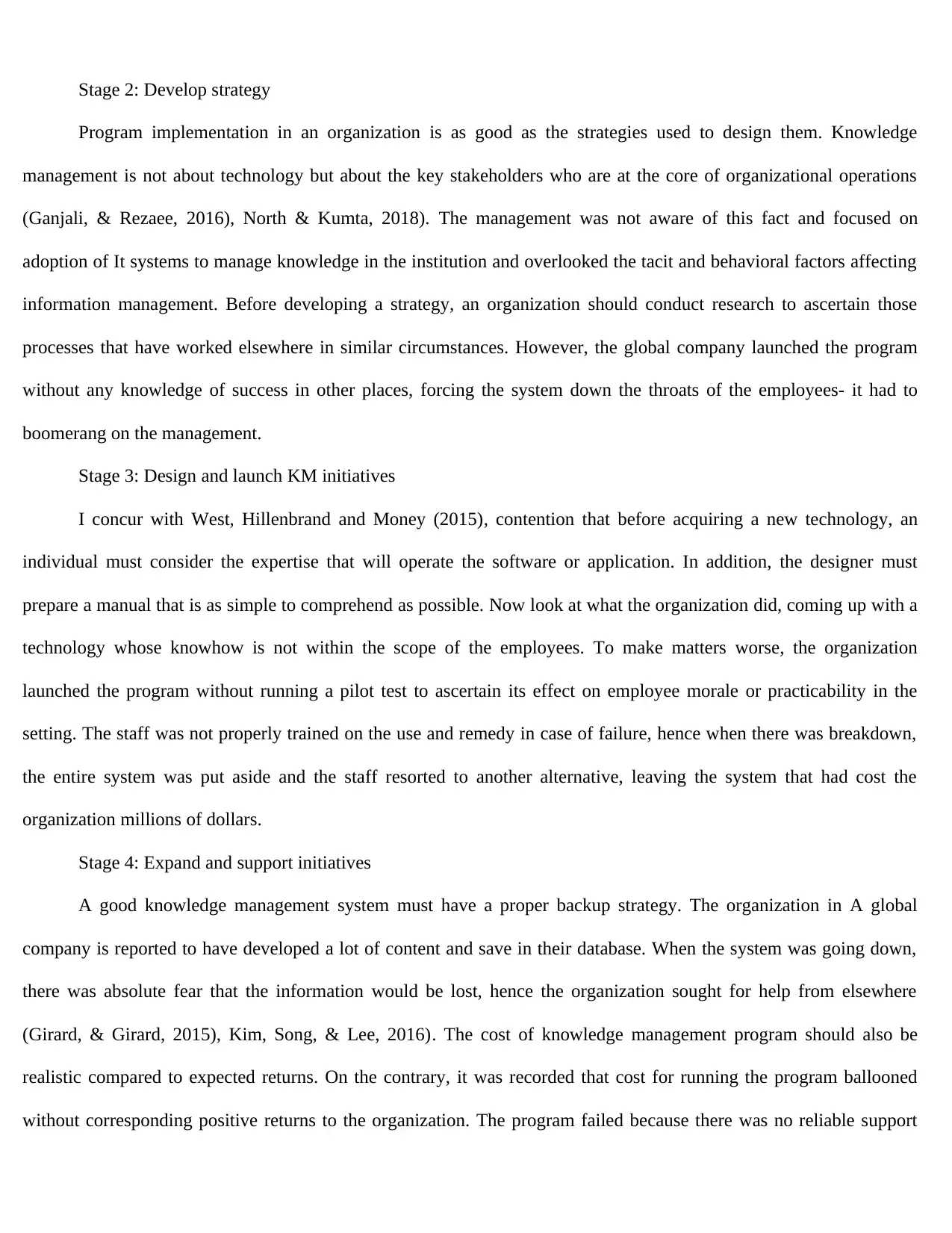
Stage 2: Develop strategy
Program implementation in an organization is as good as the strategies used to design them. Knowledge
management is not about technology but about the key stakeholders who are at the core of organizational operations
(Ganjali, & Rezaee, 2016), North & Kumta, 2018). The management was not aware of this fact and focused on
adoption of It systems to manage knowledge in the institution and overlooked the tacit and behavioral factors affecting
information management. Before developing a strategy, an organization should conduct research to ascertain those
processes that have worked elsewhere in similar circumstances. However, the global company launched the program
without any knowledge of success in other places, forcing the system down the throats of the employees- it had to
boomerang on the management.
Stage 3: Design and launch KM initiatives
I concur with West, Hillenbrand and Money (2015), contention that before acquiring a new technology, an
individual must consider the expertise that will operate the software or application. In addition, the designer must
prepare a manual that is as simple to comprehend as possible. Now look at what the organization did, coming up with a
technology whose knowhow is not within the scope of the employees. To make matters worse, the organization
launched the program without running a pilot test to ascertain its effect on employee morale or practicability in the
setting. The staff was not properly trained on the use and remedy in case of failure, hence when there was breakdown,
the entire system was put aside and the staff resorted to another alternative, leaving the system that had cost the
organization millions of dollars.
Stage 4: Expand and support initiatives
A good knowledge management system must have a proper backup strategy. The organization in A global
company is reported to have developed a lot of content and save in their database. When the system was going down,
there was absolute fear that the information would be lost, hence the organization sought for help from elsewhere
(Girard, & Girard, 2015), Kim, Song, & Lee, 2016). The cost of knowledge management program should also be
realistic compared to expected returns. On the contrary, it was recorded that cost for running the program ballooned
without corresponding positive returns to the organization. The program failed because there was no reliable support
Program implementation in an organization is as good as the strategies used to design them. Knowledge
management is not about technology but about the key stakeholders who are at the core of organizational operations
(Ganjali, & Rezaee, 2016), North & Kumta, 2018). The management was not aware of this fact and focused on
adoption of It systems to manage knowledge in the institution and overlooked the tacit and behavioral factors affecting
information management. Before developing a strategy, an organization should conduct research to ascertain those
processes that have worked elsewhere in similar circumstances. However, the global company launched the program
without any knowledge of success in other places, forcing the system down the throats of the employees- it had to
boomerang on the management.
Stage 3: Design and launch KM initiatives
I concur with West, Hillenbrand and Money (2015), contention that before acquiring a new technology, an
individual must consider the expertise that will operate the software or application. In addition, the designer must
prepare a manual that is as simple to comprehend as possible. Now look at what the organization did, coming up with a
technology whose knowhow is not within the scope of the employees. To make matters worse, the organization
launched the program without running a pilot test to ascertain its effect on employee morale or practicability in the
setting. The staff was not properly trained on the use and remedy in case of failure, hence when there was breakdown,
the entire system was put aside and the staff resorted to another alternative, leaving the system that had cost the
organization millions of dollars.
Stage 4: Expand and support initiatives
A good knowledge management system must have a proper backup strategy. The organization in A global
company is reported to have developed a lot of content and save in their database. When the system was going down,
there was absolute fear that the information would be lost, hence the organization sought for help from elsewhere
(Girard, & Girard, 2015), Kim, Song, & Lee, 2016). The cost of knowledge management program should also be
realistic compared to expected returns. On the contrary, it was recorded that cost for running the program ballooned
without corresponding positive returns to the organization. The program failed because there was no reliable support
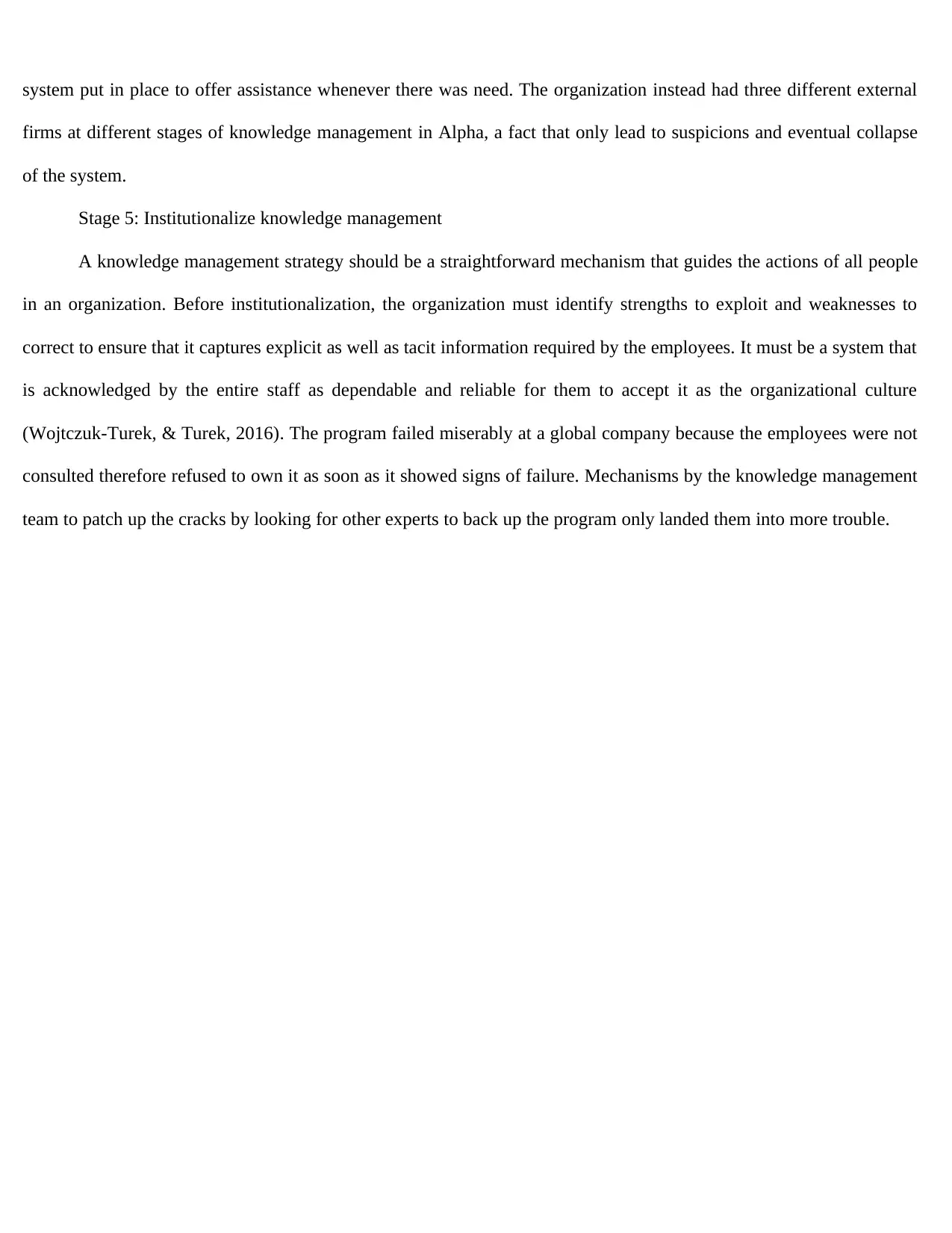
system put in place to offer assistance whenever there was need. The organization instead had three different external
firms at different stages of knowledge management in Alpha, a fact that only lead to suspicions and eventual collapse
of the system.
Stage 5: Institutionalize knowledge management
A knowledge management strategy should be a straightforward mechanism that guides the actions of all people
in an organization. Before institutionalization, the organization must identify strengths to exploit and weaknesses to
correct to ensure that it captures explicit as well as tacit information required by the employees. It must be a system that
is acknowledged by the entire staff as dependable and reliable for them to accept it as the organizational culture
(Wojtczuk-Turek, & Turek, 2016). The program failed miserably at a global company because the employees were not
consulted therefore refused to own it as soon as it showed signs of failure. Mechanisms by the knowledge management
team to patch up the cracks by looking for other experts to back up the program only landed them into more trouble.
firms at different stages of knowledge management in Alpha, a fact that only lead to suspicions and eventual collapse
of the system.
Stage 5: Institutionalize knowledge management
A knowledge management strategy should be a straightforward mechanism that guides the actions of all people
in an organization. Before institutionalization, the organization must identify strengths to exploit and weaknesses to
correct to ensure that it captures explicit as well as tacit information required by the employees. It must be a system that
is acknowledged by the entire staff as dependable and reliable for them to accept it as the organizational culture
(Wojtczuk-Turek, & Turek, 2016). The program failed miserably at a global company because the employees were not
consulted therefore refused to own it as soon as it showed signs of failure. Mechanisms by the knowledge management
team to patch up the cracks by looking for other experts to back up the program only landed them into more trouble.
⊘ This is a preview!⊘
Do you want full access?
Subscribe today to unlock all pages.

Trusted by 1+ million students worldwide
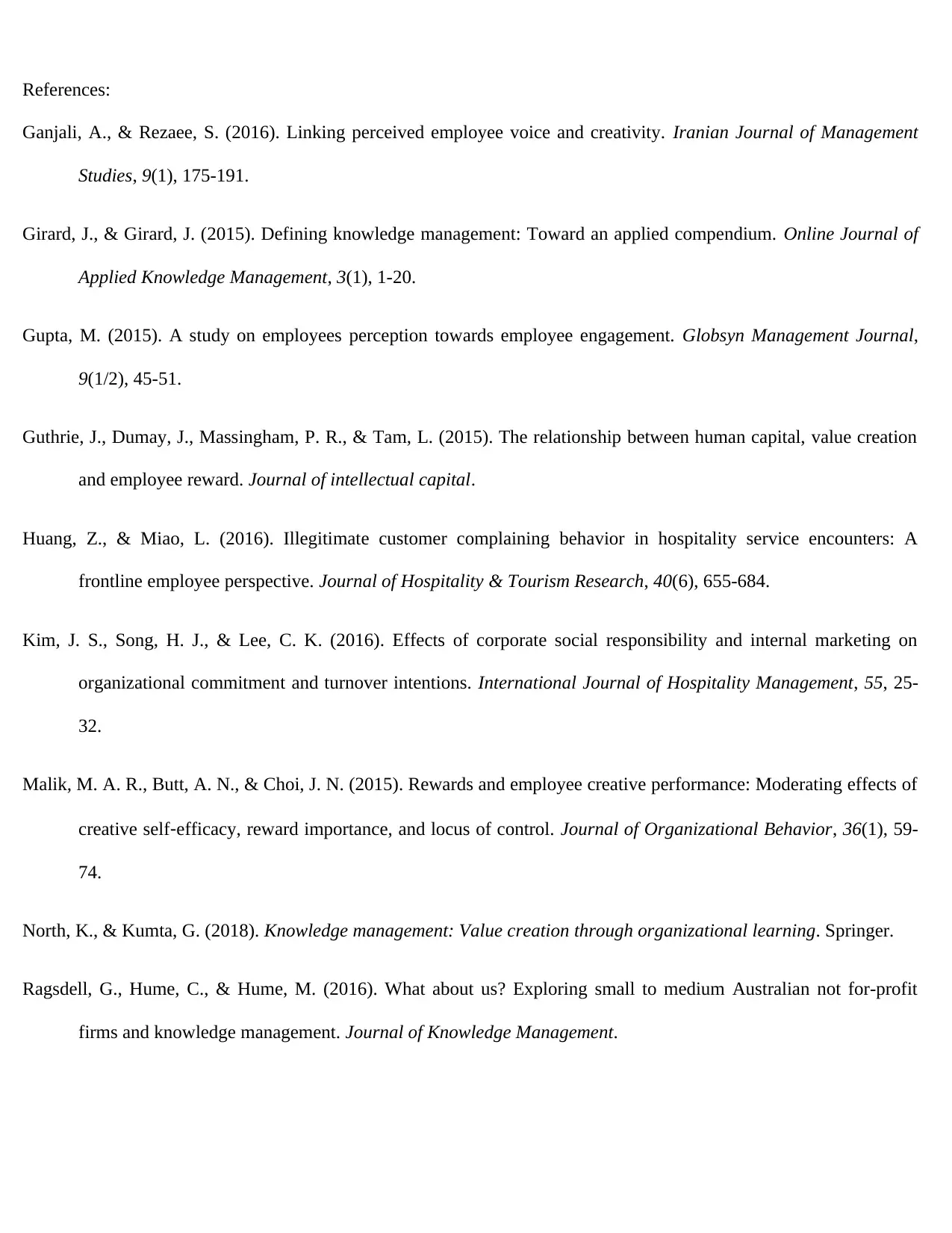
References:
Ganjali, A., & Rezaee, S. (2016). Linking perceived employee voice and creativity. Iranian Journal of Management
Studies, 9(1), 175-191.
Girard, J., & Girard, J. (2015). Defining knowledge management: Toward an applied compendium. Online Journal of
Applied Knowledge Management, 3(1), 1-20.
Gupta, M. (2015). A study on employees perception towards employee engagement. Globsyn Management Journal,
9(1/2), 45-51.
Guthrie, J., Dumay, J., Massingham, P. R., & Tam, L. (2015). The relationship between human capital, value creation
and employee reward. Journal of intellectual capital.
Huang, Z., & Miao, L. (2016). Illegitimate customer complaining behavior in hospitality service encounters: A
frontline employee perspective. Journal of Hospitality & Tourism Research, 40(6), 655-684.
Kim, J. S., Song, H. J., & Lee, C. K. (2016). Effects of corporate social responsibility and internal marketing on
organizational commitment and turnover intentions. International Journal of Hospitality Management, 55, 25-
32.
Malik, M. A. R., Butt, A. N., & Choi, J. N. (2015). Rewards and employee creative performance: Moderating effects of
creative self‐efficacy, reward importance, and locus of control. Journal of Organizational Behavior, 36(1), 59-
74.
North, K., & Kumta, G. (2018). Knowledge management: Value creation through organizational learning. Springer.
Ragsdell, G., Hume, C., & Hume, M. (2016). What about us? Exploring small to medium Australian not for-profit
firms and knowledge management. Journal of Knowledge Management.
Ganjali, A., & Rezaee, S. (2016). Linking perceived employee voice and creativity. Iranian Journal of Management
Studies, 9(1), 175-191.
Girard, J., & Girard, J. (2015). Defining knowledge management: Toward an applied compendium. Online Journal of
Applied Knowledge Management, 3(1), 1-20.
Gupta, M. (2015). A study on employees perception towards employee engagement. Globsyn Management Journal,
9(1/2), 45-51.
Guthrie, J., Dumay, J., Massingham, P. R., & Tam, L. (2015). The relationship between human capital, value creation
and employee reward. Journal of intellectual capital.
Huang, Z., & Miao, L. (2016). Illegitimate customer complaining behavior in hospitality service encounters: A
frontline employee perspective. Journal of Hospitality & Tourism Research, 40(6), 655-684.
Kim, J. S., Song, H. J., & Lee, C. K. (2016). Effects of corporate social responsibility and internal marketing on
organizational commitment and turnover intentions. International Journal of Hospitality Management, 55, 25-
32.
Malik, M. A. R., Butt, A. N., & Choi, J. N. (2015). Rewards and employee creative performance: Moderating effects of
creative self‐efficacy, reward importance, and locus of control. Journal of Organizational Behavior, 36(1), 59-
74.
North, K., & Kumta, G. (2018). Knowledge management: Value creation through organizational learning. Springer.
Ragsdell, G., Hume, C., & Hume, M. (2016). What about us? Exploring small to medium Australian not for-profit
firms and knowledge management. Journal of Knowledge Management.
Paraphrase This Document
Need a fresh take? Get an instant paraphrase of this document with our AI Paraphraser
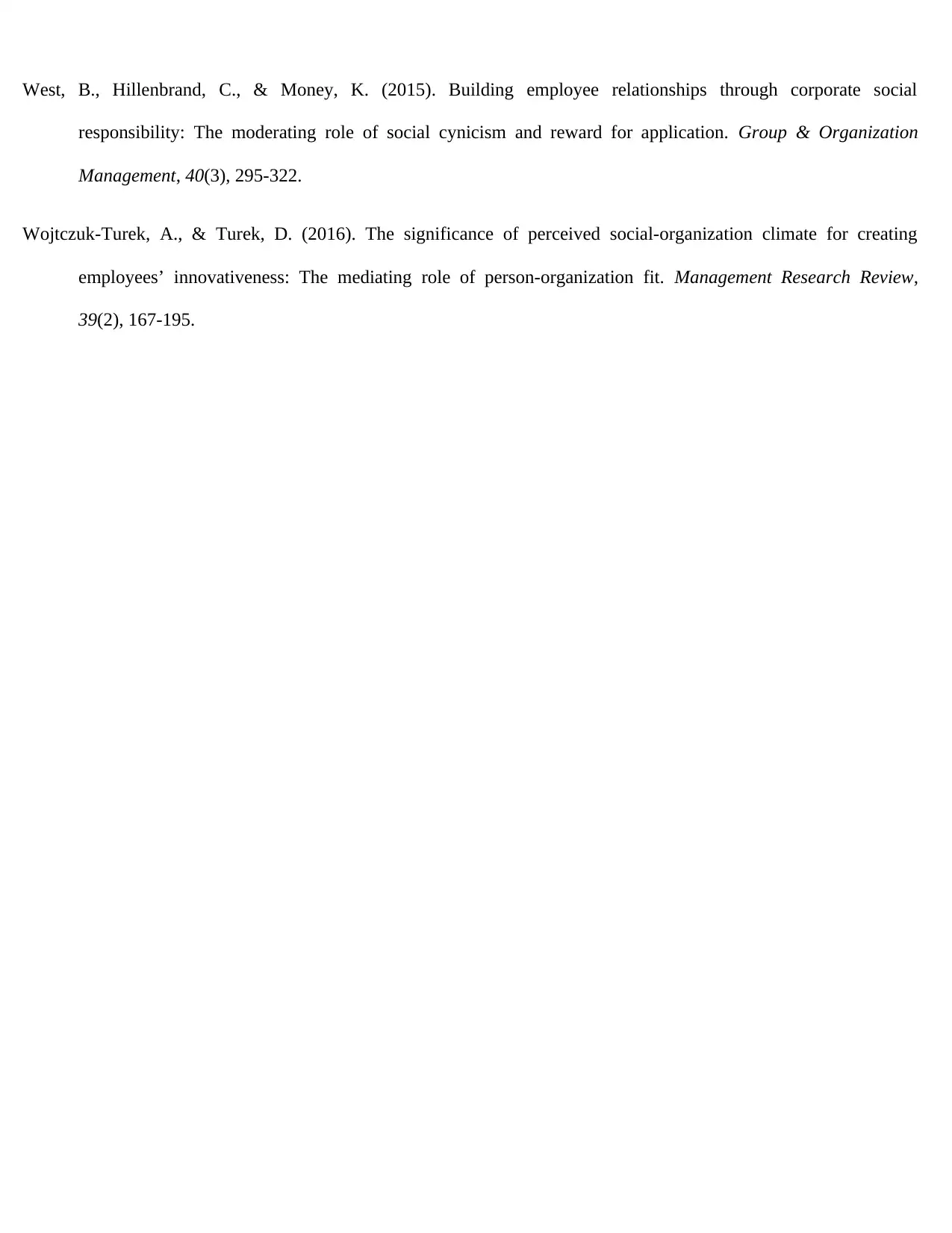
West, B., Hillenbrand, C., & Money, K. (2015). Building employee relationships through corporate social
responsibility: The moderating role of social cynicism and reward for application. Group & Organization
Management, 40(3), 295-322.
Wojtczuk-Turek, A., & Turek, D. (2016). The significance of perceived social-organization climate for creating
employees’ innovativeness: The mediating role of person-organization fit. Management Research Review,
39(2), 167-195.
responsibility: The moderating role of social cynicism and reward for application. Group & Organization
Management, 40(3), 295-322.
Wojtczuk-Turek, A., & Turek, D. (2016). The significance of perceived social-organization climate for creating
employees’ innovativeness: The mediating role of person-organization fit. Management Research Review,
39(2), 167-195.
1 out of 11
Related Documents
Your All-in-One AI-Powered Toolkit for Academic Success.
+13062052269
info@desklib.com
Available 24*7 on WhatsApp / Email
![[object Object]](/_next/static/media/star-bottom.7253800d.svg)
Unlock your academic potential
Copyright © 2020–2025 A2Z Services. All Rights Reserved. Developed and managed by ZUCOL.




